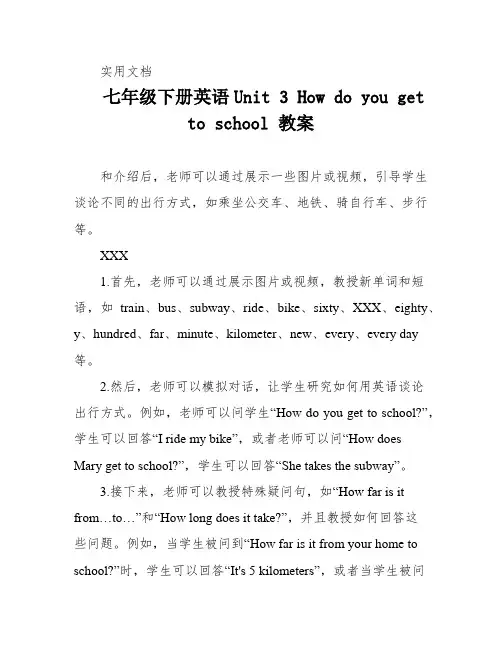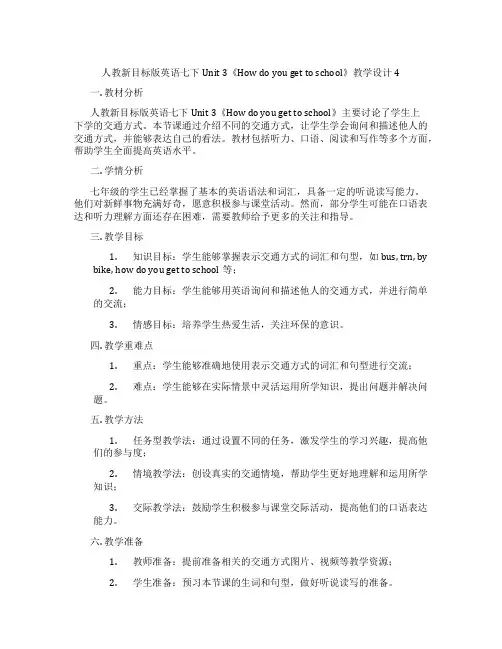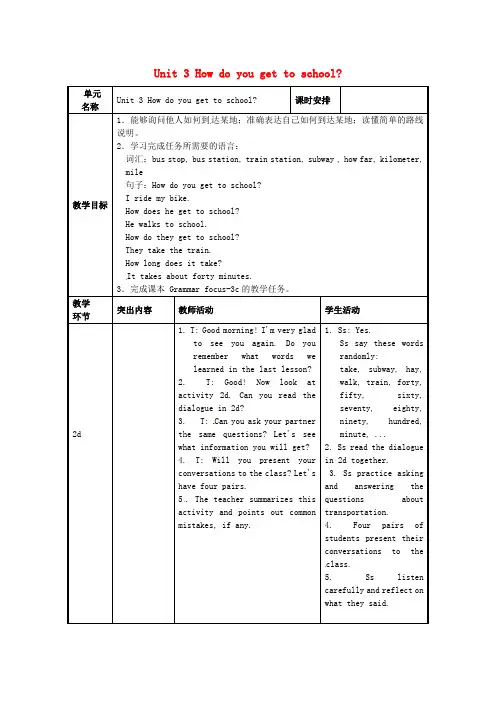新目标七下 how do you go to school 教案
- 格式:doc
- 大小:42.50 KB
- 文档页数:3

实用文档七年级下册英语Unit 3 How do you getto school 教案和介绍后,老师可以通过展示一些图片或视频,引导学生谈论不同的出行方式,如乘坐公交车、地铁、骑自行车、步行等。
XXX1.首先,老师可以通过展示图片或视频,教授新单词和短语,如train、bus、subway、ride、bike、sixty、XXX、eighty、y、hundred、far、minute、kilometer、new、every、every day 等。
2.然后,老师可以模拟对话,让学生研究如何用英语谈论出行方式。
例如,老师可以问学生“How do you get to school?”,学生可以回答“I ride my bike”,或者老师可以问“How does Mary get to school?”,学生可以回答“She takes the subway”。
3.接下来,老师可以教授特殊疑问句,如“How far is it from…to…”和“How long does it take?”,并且教授如何回答这些问题。
例如,当学生被问到“How far is it from your home to school?”时,学生可以回答“It's 5 kilometers”,或者当学生被问实用文档到“How long does it take to get to school?”时,学生可以回答“It takes 40 minutes”。
Ⅲ。
Practice1.老师可以让学生进行小组讨论,讨论在不同情况下应该选择哪种出行方式,并且给出理由。
2.老师可以让学生进行角色扮演,模拟在不同场景下的出行方式和对话。
3.老师可以让学生完成一些练,如填空、选择题等,以检验他们对所学知识的掌握程度。
XXX1.老师可以引导学生了解不同国家的出行方式和交通规则,让学生了解和尊重不同文化和惯。
2.老师可以教授一些有关交通安全和礼仪的知识,让学生养成良好的交通惯和安全意识。

Module 7
How do you go to school?
教学目标:
1.能够听、说、读、写短语:on foot,by bike,by bus,by train。
2. 能够听、说、认读短语:by plane,by ship,by subway。
3.能够用“How do you go to school? How do you go to Shanghai/Nanchong……?”询问别人的出行方式,并能够用“I go to school on foot/by bike/by bus”等进行回答。
教学重、难点:
1. 掌握四会短语。
2. 用“How do you go to school? How do you go to
Shanghai/Nanchong……?”询问别人的出行方式,并进行
回答。
学情分析:
学生以前没怎么学过英语,一些简单的日常问候语和礼貌用语都不会,他们对英语学习也不太感兴趣,因此在本节课之前用了一节课教他们唱英语歌“How Do You Go to School?”同时对歌词的中文意思进行了简单讲解。
教学过程:
1. 播放英文歌曲“How Do You Go to School?”,让学生跟着
唱一遍。
2.T:Usually I go to school on foot, but sometimes I go to school by motorbike. How about you? How do you go to school?
SS:I go to school on foot。

课程名称:新课标版七年级英语下册Unit1课时:第一课时How do you usually go to school?教材分析通过本节课的教学, 学生能够谈论有关交通工具使用情况,围绕how do you usually go to school? 展开一系列词汇,听力,对话练习。
其内容在教材中占有重要地位,为学生将来英语的学习奠定了良好的基础,其作用不容小觑。
教学内容本单元的核心内容是“运用某种交通工具去学校的表达法”。
第一,词汇。
教授学生warming-up部分的短语词汇的读音及意义。
第二,听力。
一般播放三遍录音(可以根据学生实际情况进行次数调整),然后核对答案。
第三,对话。
主要是练by bike/bus/car/subway或者是on foot及其问答。
如:how do you usually go there/…? I usually go there on foot/by bike/等。
我们可带着is it a nice day?how does mr. wu usually come to school?what is wrong with his bike?教学对象分析课前,教师可以对学生进行简短调查,了解学生对本节课的看法和意见。
七年级学生通过小学英语学习以及上册书本的学习,积累了一定的英语词汇短语,句型语法知识。
因此,学生知道如何进行英语学习,并且能在教师的指导帮助下获得进步与提高。
结合现代多媒体教学技术展开教学,吸引学生兴趣。
教学目标一知识与技能:能读懂,听懂,说出,写出相关主题的词汇句子,积累一定的英语知识。
二过程与方法:教师引导学生对知识进行分析处理,运用多媒体手段增强学生学习,并结合教材,对相关知识获得进一步裂解和认识。
三情感态度与价值观:通过对出行交通工具的选择与学习,学生能够体会现代交通对生活的积极作用和影响。
并且有利于帮助学生树立绿色出行的健康观念,为环保事业贡献一份力量。

人教新目标版英语七下Unit 3《How do you get to school》教案2一. 教材分析人教新目标版英语七下Unit 3《How do you get to school》主要围绕学生日常生活和学习中的交通方式展开。
通过本单元的学习,学生能够掌握有关交通方式的词汇和表达方式,以及询问和描述他人交通方式的基本句型。
本单元的关键句子结构是“How do you get to …?”和“I get to … by …”,以及描述交通方式的常用词汇。
二. 学情分析七年级的学生已经具备了一定的英语基础,能够进行简单的日常交流。
但部分学生在发音和听力方面还存在困难,需要重点关注和指导。
学生对于描述自己和他人的交通方式比较感兴趣,因此在学习过程中应充分利用这一点,激发学生的学习兴趣。
三. 教学目标1.知识目标:学生能够掌握描述交通方式的词汇和表达方式,以及询问和描述他人交通方式的基本句型。
2.能力目标:学生能够在日常生活中运用所学句型询问和描述他人的交通方式,进行简单的交流。
3.情感目标:培养学生热爱生活,关注环境保护的意识。
四. 教学重难点1.重点:描述交通方式的词汇和表达方式,以及询问和描述他人交通方式的基本句型。
2.难点:正确运用所学句型进行实际交流,注意语音、语调的准确性。
五. 教学方法采用情境教学法、交际法、任务型教学法等多种教学方法,通过设定真实的生活情境,引导学生参与课堂活动,提高学生的语言实践能力。
六. 教学准备1.教具:多媒体课件、图片、交通工具模型等。
2.教学资源:教材、教学参考书、网络资源等。
七. 教学过程1.导入(5分钟)利用多媒体课件展示各种交通工具的图片,引导学生谈论自己喜欢的交通工具。
教师通过提问引导学生思考:“How do you get to school?”,激发学生的学习兴趣。
2.呈现(10分钟)教师展示教材中的插图,引导学生观察并说出图中人物的交通方式。



人教新目标版英语七下Unit 3《How do you get to school》教学设计4一. 教材分析人教新目标版英语七下Unit 3《How do you get to school》主要讨论了学生上下学的交通方式。
本节课通过介绍不同的交通方式,让学生学会询问和描述他人的交通方式,并能够表达自己的看法。
教材包括听力、口语、阅读和写作等多个方面,帮助学生全面提高英语水平。
二. 学情分析七年级的学生已经掌握了基本的英语语法和词汇,具备一定的听说读写能力。
他们对新鲜事物充满好奇,愿意积极参与课堂活动。
然而,部分学生可能在口语表达和听力理解方面还存在困难,需要教师给予更多的关注和指导。
三. 教学目标1.知识目标:学生能够掌握表示交通方式的词汇和句型,如bus, trn, bybike, how do you get to school等;2.能力目标:学生能够用英语询问和描述他人的交通方式,并进行简单的交流;3.情感目标:培养学生热爱生活,关注环保的意识。
四. 教学重难点1.重点:学生能够准确地使用表示交通方式的词汇和句型进行交流;2.难点:学生能够在实际情景中灵活运用所学知识,提出问题并解决问题。
五. 教学方法1.任务型教学法:通过设置不同的任务,激发学生的学习兴趣,提高他们的参与度;2.情境教学法:创设真实的交通情境,帮助学生更好地理解和运用所学知识;3.交际教学法:鼓励学生积极参与课堂交际活动,提高他们的口语表达能力。
六. 教学准备1.教师准备:提前准备相关的交通方式图片、视频等教学资源;2.学生准备:预习本节课的生词和句型,做好听说读写的准备。
七. 教学过程1.导入(5分钟)教师通过展示不同的交通方式图片,引导学生谈论自己平时是如何上学的。
同时,询问学生是否知道其他同学的上学方式,为接下来的课堂活动做好铺垫。
2.呈现(10分钟)教师播放教材中的听力材料,让学生听懂对话内容,并回答相关问题。

Howdoyougotoschool英语教案及反思doyougotoschool 教学目标:1.KnowledgeandAbilityAim(1)Learnandtrytoundertandandreadtheword:bybu,walktochool,byc ar,bybike2.ProceandMethodAimUeTak-baedLearningandSituationLearning.3.EmotionAim:Cooperatewellandhelpwitheachother.重点难点:1.KeypointTalkaboutthewayofgoingtochoolinreal-lifeituationbyuingthephrae:bybu,walktochool,bycar,bybikeanddrill :Howdoyougotochool2.DifficultieHowtouethenewwordandthedrilltoTalkaboutthewayofgoingtochoolf reelyandfluentlyinourdailylife.教学准备:Tape-recorder,Card,CAI教学过程:一、Warmingup1.Greeting:Clabegin.Standup!Goodmorning,boyandgirl.HowareyouLet’chant:play----Iplay,youplay,heplay,heplay,itplay.go----Igo,yougo,hegoe,hegoe,itgoe.2.Freetalk二、Tak-preentingandpreparing1.TodayIbringthreefriendtoyou,nowlook!(Showthreeheadornament)Openyourbook,turntopage30,litenandpoint.2.Let’litenagain,Iwillak:③DoeTomgotochoolbycar3.Afterlitening,anwerthequetion:Igotochoolbybu./Shegoetochoolbybu.(ShowCAI:pictureofbuand“bybu”,doaction,readthephraetwobytwo,thenboyandgirl.)Iwalktochool./Shewalktochool.(ShowCAI:pictureofwalkand“walk tochool”,doaction,readthephraetwobytwo,thengroupbygroup.)③DoeTomgotochoolbycar(ShowCAI:pictureofcarand“bycar”,doaction,readthephraetwobytwo,thenrowbyrow.)No,hedoen’t.Hegoetochoolbybu.Hegoetochoolbybu.(ShowCAI:pictureofbikeand“bybike”,doaction,readthephraetwobytwo,thenboyandgirl)5.Readthefourphraeanddoaction:bybu,walk,bycar,bybikePractieingroup.6.Playagamebetweenfourgroup:Teacherdoeaction,tudentay.Studentdoeaction,tudentay.三、Practiingandcouneling1.Look!Aphotoofme.(ShowCAI)Igotoworkbybu.What’meaningof“go towork”Gue!Readthephraerowbyrow,thentogether.2.(Showheadornament)Look,anewfriend.HeiLingling’father.Igotoworkbybu.Let’lit en!Howdoehegotowork3.Afterlitening,anwerthequetion:Howdoehegotowork4.Akandanwer:Howdoeyourfathergotowork5.Doyouknow:HowdoemyfathergotoworkGue!HeworkinShanghai.Hegoetoworkbyhip.Readanddoaction.6.TheOlympicGamewillbeheldinBeijingin2022.MyiterwanttogotoBeijing.HowdoehegotoBeijingShegoetoBeijingbyplane.Readanddoaction.ShegoetoBeijingbytrain.Readanddoaction.7.Readthephraeanddoaction:Bybu,walktochool,bycar,bybike,byhip,byplane,bytrain8.Playgame:①Teacherdoeaction,tudentay.②TeacherhowCAI,tudentgue.四、Tak-fulfilling1.Litenandpoint.2.Litenandrepeat.3.Litenandcircleomephraeandword.4.Checkthewordandphrae.5.Practiebythetudent.6.Showtudent’photoandaythewayofgoingtochool.五、Sumupandhomework.Howdoyougotochool教学反思在教Howdoyougotochool这节课时,我用了这些教学方法。

《How do you go to school?》教学设计
高,到达了“调查者、被调查者与其他学生〞之间的互动交流。
例如一生问:How do you go to s chool? 生1答复:I go to school by bus.生2马上接着答复:I go to school by bu
s too. 生1和生2合说:We go to school b y bus.其他学生马上用手指着生1和生2:They g o to school by bus.
总之,我觉得课堂上能面向每个学生,设计的活动让每个学生都能参与进来;同时培养学生“会倾听、敢发言、会交流、会合作〞的良好的英语学习习惯。
但是也存在一些问题,如环节之间的衔接不是很自然,课文录音只听了一遍等等。
课堂教学的精益求精是我在今后教学中应该追求的,任何时候都不应该满足于现状。
要随时发现自己的缺乏之处,以便及时改正。
只有不断地反思,才能取得更大进步。

人教版新目标英语七年级下册《Unit 3 How do you get to school》教案7一. 教材分析本节课是新人教版新目标英语七年级下册的第三单元《How do you get to school》。
本单元主要让学生掌握一般现在时的疑问句和回答,以及如何描述自己和别人的上学交通工具。
通过本节课的学习,学生能够更好地运用英语进行日常交流。
二. 学情分析七年级的学生已经掌握了基本的英语语法知识,具备一定的听说读写能力。
但是,一部分学生对英语学习的兴趣不高,课堂参与度较低。
此外,学生们的英语水平参差不齐,因此在教学过程中需要关注到每一个学生的学习需求。
三. 教学目标1.能够听懂、会说、会读本节课的主要词汇和句型。
2.能够运用一般现在时询问和回答他人上学的交通工具。
3.提高学生的英语听说能力,增强他们对英语学习的兴趣。
4.培养学生的合作意识和团队精神。
四. 教学重难点1.掌握一般现在时的疑问句和回答。
2.能够正确运用词汇描述上学交通工具。
3.提高学生的听说能力和团队合作能力。
五. 教学方法1.任务型教学法:通过小组合作完成任务,提高学生的参与度和团队合作意识。
2.情境教学法:创设生活情境,让学生在实际语境中运用英语。
3.游戏教学法:运用游戏激发学生的学习兴趣,提高课堂氛围。
六. 教学准备1.制作课件:包括本节课的主要词汇、句型和图片。
2.准备相关道具:如交通工具的模型或图片。
3.设计教学活动:如小组讨论、游戏等。
七. 教学过程1.导入(5分钟)利用多媒体展示各种交通工具的图片,引导学生谈论自己上学的方式。
教师通过提问激发学生的兴趣,如:“How do you usually go to school?”学生回答后,教师简要介绍本节课的内容。
2.呈现(10分钟)教师展示本节课的主要词汇和句型,如:“I go to school by bus.”学生跟读并模仿,教师给予表扬和鼓励。
3.操练(10分钟)学生分组,每组选择一种交通工具,用英语描述自己的上学方式。

Unit 3 How do you get to school?单元名称Unit 3 How do you get to school? 课时安排教学目标1.能够询问他人如何到达某地;准确表达自己如何到达某地;读懂简单的路线说明。
2.学习完成任务所需要的语言:词汇:bus stop, bus station, train station, subway , how far, kilometer, mile句子:How do you get to school?I ride my bike.How does he get to school?He walks to school.How do they get to school?They take the train.How long does it take?It takes about forty minutes.3.完成课本 Grammar focus-3c的教学任务。
教学环节突出内容教师活动学生活动2d 1. T: Good morning! I'm very gladto see you again. Do youremember what words welearned in the last lesson?2. T: Good! Now look atactivity 2d. Can you read thedialogue in 2d?3. T: Can you ask your partnerthe same questions? Let's seewhat information you will get?4. T: Will you present yourconversations to the class? Let'shave four pairs.5. The teacher summarizes thisactivity and points out commonmistakes, if any.1. Ss: Yes.Ss say these wordsrandomly:take, subway, hay,walk, train, forty,fifty, sixty,seventy, eighty,ninety, hundred,minute, ...2. Ss read the dialoguein 2d together.3. Ss practice askingand answering thequestions abouttransportation.4. Four pairs ofstudents present theirconversations to theclass.5. Ss listencarefully and reflect onwhat they said.ourtakethis unit here. Can you find out the difference between the sentences here and the sentences we used just now? Do you know how to askthethea... and we also uselength of time. For example, we saysomething takes five minutesor takes one hour. So we usethe same word, take, in twofromthe sentences listed inthe book and theirown conversations.more examples from the boo k3a, 3b Reading1. T: Ask a few students how theyget to school in the morning? Howlong does it take?2. T: Now let's look at 3a. Whatquestions do we have here? Cansomeone read the questions forus?3. T: Now please read the passagequickly and find the answers tothe questions.4. T: Can you share your answers?The teacher asks a couple ofstudents to give their answers tothe questions.5. The teacher checks theanswers. And then the teacherasks a few students how they aredifferent from Lin Fei.Example questions:How far is your home fromschool?What time do you get up?1. A few students answerthe questions as theteacher asks them.2. A student volunteersto read the questions in3a.3. Students read thepassage.4. Students giveanswers.5. Ss think about theirown life and answer thequestions withdifferent answers.6. Ss say what theylearn from the pictures,such as transportation,times, distances, etc.7. A pair ofstudents read aloudthe dialogue.How do you get to school?6. T: Very good. Now let's look at 3b. What do you know from the pictures here?7. T: Good. I'd like to invitea pair of students to read the sample dialogue for us. Who'd like to try?8. T: Now work with a partner and make your own conversations using the information in the pictures. You have 5 minutes to prepare, and after that, I will ask some of you to present your conversations. (The teacher walks around to give support if necessary.)9. T: Ok, time is up. Who'd like to try?10. The teacher summarizes students' performance. Call students' attention to the common mistakes they made in their conversations. 8. Students work in pairs.9. Some students present their conversations.10. Students reflect what they have done.4 InformationgapThe teacher explains how to playthe game. If necessary, theteacher can play one of roles togive a clear demonstration.Students learn what todo in the game and thenplay the game in groupsof three.Summary The teacher calls students'attention again to grammar focusand highlight the functions ofthe structures.Students reflect whatthey have done.板书设计Unit 3 How do you get to school? How do you get to school?I ride my bike.How does he get to school?He walks to school.How do they get to school?They take the train.How long does it take?It takes about forty minutes.。
人教新目标版英语七下Unit 3《How do you get to school》教学设计2一. 教材分析人教新目标版英语七下Unit 3《How do you get to school》主要介绍了各种交通工具和询问别人如何去学校的方式。
本节课的主要内容是通过询问和回答的方式,让学生学会用英语描述自己和其他人是如何去学校的。
教材中包含了丰富的图片和实用的对话,为学生提供了良好的学习材料。
二. 学情分析七年级的学生已经掌握了基本的英语语法和词汇,对学习英语有浓厚的兴趣。
但部分学生可能在口语表达和听力方面存在一定的困难。
因此,在教学过程中,需要关注学生的个体差异,鼓励他们积极参与课堂活动,提高他们的口语表达和听力能力。
三. 教学目标1.能熟练运用本节课所学词汇和句型,描述自己和其他人是如何去学校的。
2.提高学生的口语表达和听力能力。
3.培养学生的团队合作精神。
四. 教学重难点1.掌握并能熟练运用本节课所学词汇(如:bus, trn, car, bike等)。
2.学会用英语询问和回答别人如何去学校的问题。
3.正确使用情态动词“can”和“must”进行疑问和回答。
五. 教学方法1.情境教学法:通过设置真实的场景,让学生在实际情境中学习和运用英语。
2.交际教学法:鼓励学生积极参与课堂互动,提高他们的口语表达和听力能力。
3.任务型教学法:通过完成各种任务,让学生在实践中掌握所学知识。
六. 教学准备1.准备相关交通工具的图片和卡片。
2.制作多媒体课件,展示各种交通工具和相关的句子。
3.准备录音机和磁带,播放相关的听力材料。
七. 教学过程1.导入(5分钟)利用图片和卡片,引导学生谈论各种交通工具,为新课的学习做好铺垫。
2.呈现(10分钟)展示多媒体课件,呈现本节课的主要内容。
通过动画和图片,让学生直观地了解各种交通工具和询问别人如何去学校的方式。
3.操练(10分钟)让学生分成小组,用所学的句型互相询问和回答如何去学校的问题。
人教版新目标英语七年级下册《Unit 3 How do you get to school》教学设计6一. 教材分析人教版新目标英语七年级下册Unit 3 How do you get to school? 主要讨论了学生们上学的交通方式。
本单元通过描述不同人的交通方式,让学生们学会询问和描述别人的交通方式,培养他们的交际能力。
教材包括听、说、读、写等多种活动,帮助学生们掌握相关词汇和句型,提高他们的语言运用能力。
二. 学情分析七年级的学生已经掌握了基本的英语语法和词汇,具备一定的听说读写能力。
他们对学习英语有浓厚的兴趣,但有时候可能会对一些复杂的句子结构和词汇感到困惑。
因此,在教学过程中,需要关注学生的个体差异,因材施教,激发他们的学习兴趣,帮助他们克服学习困难。
三. 教学目标1.知识目标:让学生掌握描述交通方式的词汇和句型,如by bus, onfoot, by trn等。
2.能力目标:培养学生询问和描述别人交通方式的能力,提高他们的交际能力。
3.情感目标:培养学生热爱生活,关注环境保护的意识。
四. 教学重难点1.重点:让学生学会描述自己和他人的交通方式。
2.难点:掌握句型How do you get to school? 和描述交通方式的词汇。
五. 教学方法采用任务型教学法,通过听、说、读、写等多种活动,让学生在实际情境中学会描述交通方式,提高他们的语言运用能力。
同时,运用分组合作、讨论等教学手段,激发学生的学习兴趣,培养他们的团队协作能力。
六. 教学准备1.教师准备:提前准备好相关交通方式的图片、视频等教学资源。
2.学生准备:预习本节课的生词和句型。
七. 教学过程1.导入(5分钟)利用图片或视频展示不同的交通方式,引导学生谈论他们上学的交通方式,激发学生的学习兴趣。
2.呈现(10分钟)展示教材中的情景图,引导学生观察并回答问题:How do they get to school? 让学生听录音,完成练习题,加深对教材内容的理解。
Unit 2 How Do You Go to School?教案一、学习目标:1. 学生能听说新单词:bus, train, ship, taxi, school, home.2. 学生能知会短语的意思以及运用场合。
by bus, by train, by ship, by taxi, on foot.3. 创设情境,培养学生主动学习、创造学习的能力。
4. 学习短语:go on foot, drive a car, ride a bike, take a bus.5. 学习句型:H ow do you go to school? How long does it take to …?6. 学习用英语询问他人去学校乘坐什么交通工具。
7. 能够正确替换交通工具。
二、教学重难点:1. 教学重点:a. 能够听说读写单词:bus, train, ship, taxi, school, home.b. 熟练掌握短语和句型,并进行简单的对话。
c. 掌握句型How do/does ... go to school?How long does it take to …?2. 教学难点:通过学习,能够熟练掌握交通工具的用法。
a. 学会正确使用交通工具前的介词,并能适当进行句型替换。
b. 掌握单数第三人称以及复数的情况下do和动词go的变化。
三、教学过程:1. 老师提问How do you come to school?学生可能会用汉语说出步行,骑自行车。
师拿出自行车、小船等模型复习单词bike, ship来引入单元主题。
XX goes to school by bike.This is a new friend Ben. Ben lives far away, so he comes to school by ship. Today let’s learn more new words.2. 阅读方法。
对照课本,边看边练习拼写描述交通工具的单词,并学着理解每个句子的意思。
Unit 3 How do you get to school?教材解读本单元以Transportation为话题,通过单元教学,学生将学会用三个how questions 谈论如何到达一个目的地,行程多长时间及距离有多远。
另外,学生还将掌握不同交通方式的英语表达,了解不同国家和地区的学生是采用何种交通方式去学校的。
学好本课,学生还能够加深对一般现在时态的理解和运用,也可以用英语来和别人讨论到达某地的最佳方式。
单元目标一、知识与技能1. 掌握重点单词及短语。
2. 了解世界不同地区学生的上学方式。
3. 学生能表达自己和周围同学的交通方式。
二、过程与方法采用Using contest guessing和Role playing的学习策略,利用教学图片、录音机或多媒体课件来展开课堂的听力和口语交际活动。
三、情感态度与价值观不同的出行目的可以选择不同的交通工具,不同交通工具带来不同的心灵感受,让学生懂得从环保这一角度出发,了解交通工具给环境带来的影响,尽量选择低碳环保的交通工具出行。
教法导航采用直观教学法,遵循以学生为主体的原则。
学法导航采用Using contest guessing和Role playing的学习策略,课时支配第1课时:Section A 1a─2c 第2课时:2d─3c第3课时:Section B 1a─1e 第4课时:2a─Self Check第1课时 Section A 1a-2c教学目标一、知识与技能1. 掌握重点词汇和句型:take the bus, ride a bike, How do you get to school?2. 复习数字的表达。
3. 培养听力能力。
二、过程与方法采用目标和直观教学法,调动学生的积极性,引导他们积极参与课堂。
三、情感态度与价值观了解其他国家的常见出行方式,培养低碳环保出行的意识。
教学重点能用本课的重点词汇和句型对出行方式进行交际。
教学难点能听清录音中的较大数字。
Unit 3 How do you get to school?单元名称Unit 3 How do you get to school? 课时安排教学目标1.能够询问他人如何到达某地;准确表达自己。
2.学习完成任务所需要的语言:1) 词汇:north, east, south, west, North America, school bus, depend, by boat,must, car2) 句子:复习表达如何向别人询问道路:How do you get to school?How does Nina get to school?继续学习表达采用怎样的交通方式去某地:Well, I ride my bike to the subway station.Then I take the subway.学会转述他人怎样通过交通方式去某地。
Some students also walk or ride bikes o school.了解不同国家交通方式的差别。
3.完成课本第23页3a, 3b, self check的教学任务。
教学环节突出内容教师活动学生活动Step ILead in and revision 题板PPT 11. T: I'm very glad to see you again.Do you remember what transportationwe learnt in last lesson? 大家还记得上节课我们都学习了哪些提问和回答交通方式的句子么?1) (老师用引导出交通方式句子的卡片指引学生说出所学句子。
)How do you get to school?Well, I ride my bike to the subwaystation.Then I take the subway.2) T: Do you know how to make them?电视机前的同学们你们还记得吗?Look at the picture. Please make thedialogue as last lesson.我们一起看图片。
Unit 3词组:ride a bike 骑自行12 , get to…到达1.the bus ride 公共汽车行程13 , by bike 骑自行车2.by bus 乘公交车14, have a good day 祝一天愉快3.at school 在学校15 , ride one’s bike 骑某人的自行车4.drive to work 开车上班16 , walk to school 走路上学5.bus stop 公车站17, subway station 地铁站6.think of 认为18, between A and B 在A和B之间7.cross the river 过河19,play with…和…一起玩e true 成真20, have to 不得不9.thanks for 为…而感谢21, talk to…和…交谈10.11,your trip to…你的22 ,take the train / bus / subway乘火车/ 公共汽车/ 地铁单选:( )1. Henry goes to work _____ car and Victor goes to work _____ foot.A. on, byB. on, onC. by, byD. by, on( )2 . It usually takes us twenty minutes _____ to the supermarket.A. walkB. walksC. to walkD. walking( ) 3. Miss Evans lives far form the company, so she usually ____ the subway to work.A. ridesB. byC. takesD. on( )4, “By water” means _______.A. on boatB. by a boatC. taking boatD. by boat( ) 5, 2. Jeff goes to work _______ and his wife goes to work ______ .A. by car, on her bikeB. by a car, on her bikeC. by cars, by bikesD. by his car, by bike( ).6 --- _______ does it take you to get to Beijing? --- Twenty hours.A. How oftenB. How farC. How manyD. How long( ) 7 ______ does it take you to finish_________the book?A. How long, to readB. How soon, to readC. How often, readingD. How long, reading( ) 8, ______ do you think of your father ?A ,HowB . whatC .A,B both D. who( ) 9, My mother always _______ work __________ half an hour .A, walks ;at Bwalks to ; at C.walks ; for D,walks to ; for( )10 . He wants to make his dream ________A ,come true es true e trues D ,true( )11, stop ______,everyone , let’s have our classA.talking B ,to talk C ,talk D saying( ) 12 . There are about _________ people in the room .A . two hundredsB two hundreds ofC , two hundredD hundred of( )13, The library is ______ the school ______ the storeA, from ;to B , between ; to C. between , and D, between, from( ) 9. Lily and Amy often leave _____ school _____ half past seven.A. from, toB. for, inC. to, fromD. for, at( )14. ― How do you ________there? ―I take the train.A. reachB. get toC. arriveD. arrive in( )15. The new amusement park is about five kilometers ____.A. farB. far awayC. away fromD. away( ) 16. I have two cats. One is black, and ______ is white.A. anotherB. someC. otherD. the other句型;翻译:1,Mary怎么去学校?她通常骑自行车上学。
________________________________________________________________________________2, 你弟弟上学用多长时间?____________________________________________________________________________________________________ 3, 你家离学校多远?______________________________________________________________________________________________________4, 我家离学校大概有两公里远吧。
______________________________________________________________________________________5, 你的四川之旅怎样?6, 玛丽想知道鲍勃住在哪里___________________________________________________________________________7, 他是一个两个月大的baby .______________________________________________________________________________ 8, 对我来说他像父亲一样________________________________________________________________________完型填空:Danny is a schoolboy. He 31 in a small town. His home is about ten miles 32 school and the roads are not flat(平坦的). So it’s 33 for him to get to school. He 34 at about five thirty every day and has breakfast. Then he 35 school at around six o’clock. First, he 36 his bicycle to the bus station. That takes about forty minutes. 37 the bus takes him to school. It usually takes about thirty minutes. Sometimes he has 38 time for breakfast at home, so he has something for breakfast on the bus. “I’ve never taken trains. It must be a lot 39 fun than taking buses,” says Danny. He studies very 40 at school. He hopes he can go to school in a big city some day. He can take a train to school then.( )31. A. lives B. works C. plays D. teaches( )32. A. at B. from C. in D. for( )33. A. easy B. good C. interesting D. difficult( )34. A. gets up B. gets to C. goes to bed D. goes to work ( )35. A. gets back B. leaves for C. leaves D. gets( )36. A. by B. sends C. on D. rides( )37. A. Then B. But C. Ago D. After( )38. A. much B. no C. not D. a( )39. A. little B. less C. more D. many( )40. A. badly B. bad C. hardly D. hard。